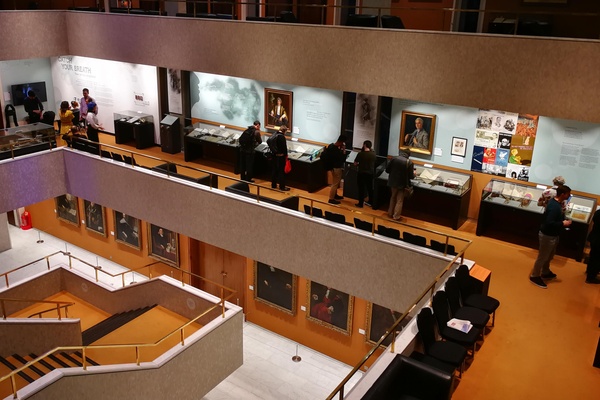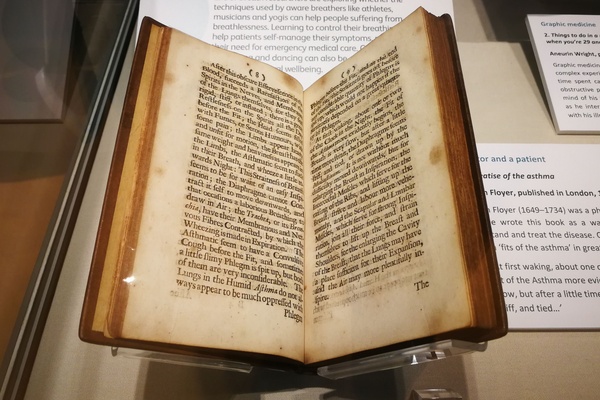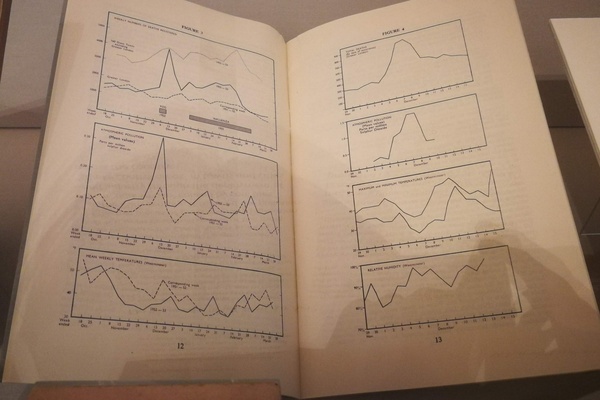Catch Your Breath moves to London
by Sarah McLusky, Project Manager
After just a two week lull, the second incarnation of Catch Your Breath opened in London at the Royal College of Physicians (RCP) earlier this month. Those of you who visited the exhibition in Durham will immediately recognise the overall design and colour scheme. Many of the objects will be familiar too. But as you would expect, the RCP exhibition has been reorganised both to suit their space and audience, and supplemented with items from their own collections.

RCP have their own vast archive of books, art, objects and other items relating to the history of medicine. Some of their respiratory-related items, like the collection of stethoscopes and inhalers, made the journey to Durham. Many others were either too fragile or valuable to travel, weren’t appropriate for the audience in Palace Green Library, or simply wouldn’t fit in the space available at Durham.
The RCP team have thoroughly enjoyed digging into their treasures to uncover some interesting additions, particularly around the diagnosis and treatment of breathlessness over the centuries. Notable examples include a copy of herbalist Nicholas Culpeper’s The London Dispensatory book (1654), which lists remedies made from fox lungs, a ‘wet drug’ jar from the same era and an early (1698) account of asthma symptoms by Sir John Floyer. Being in London has also facilitated loans from other museums and collections including tobacco enema bellows and a radiography camera from the Science Museum and a pack of asthma cigarettes – quite an oxymoron – on loan from the Royal Pharmaceutical Society Museum.

Culpeper’s book (1654) and a medicine jar 
Asthma cigarettes 
A Treatise of the Asthma by Floyer (1698)
Where some RCP items couldn’t travel to Durham, the reverse is also true. For example, Durham University’s 14th century edition of Troilus and Cresiyde has been replaced with a modern reprint – easier to read, if not as visually striking. And due to space limitations, visitors will be able to enjoy some different examples of Jayne Wilton’s artwork – the 3D print of the word Happen is replaced by the no less striking Concern alongside a smaller version of Breath which turns back towards itself.
Being located just off Euston Road, one of the most polluted roads in the capital, it made sense that RCP would place a greater emphasis on air pollution. Air pollution in London is nothing new – in Charles Dickens’ Bleak House (1874) the fog that hangs over the Victorian city is a central character, representing disease and corruption. The London exhibition also features a Ministry of Health report, which shows the scale of the health problems caused by the Great Smog of 1952, alongside modern items like a cycling mask and a map showing less polluted routes around the capital.

Another local addition is the first case visitors will see on arrival, which has been co-curated with Breathe Easy Westminster, a support group for people with respiratory conditions. Group members were asked to donate items which help them to manage their breathlessness and those on display range from a fan (moving air across the face can relieve air hunger) to a mug which represents the social support received from the group.

Like in Durham, we had a number of events planned which will help bring the exhibition to life. On the first Thursday of every month RCP opened their doors after hours until 8pm. During these RCP Lates we organised some talks, workshops and drop-in activities led by members of our research team and collaborators. For April we had sessions on dance, movement and breathing exercises. On Thu 2 May there were further Dance Easy tasters with Sian Williams alongside a talk by artist Miriam Quick.
On 30 April RCP hosted a celebration of the tenth anniversary of one of the first signing groups for people with lung disease. The Singing for Breathing group, based at the Royal Brompton hospital performed The Singing Hospital a new commission by Victoria Hume.



